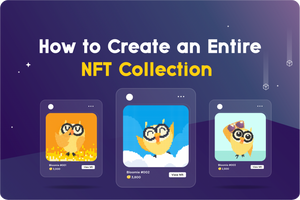In one of our previous blog articles, we covered an introduction to NFTs, what they are, the basics of how they work and showed some examples.
👀 In this post, we’ll examine the best ways to create your own NFT art collection, whether it's just a small batch of NFTs, or a large 10,000 NFT collection. While success can’t be guaranteed, there are things you can do to improve your chances of creating something valuable.
✍️ CREATING YOUR NFTs
While NFTs can be almost anything in a digital format, the NFTs we are discussing in this post would be art-based still images. NFT collections are usually an assortment of computer-generated🖥️ characters🧑🏻🤝🧑🏿 that portray a specific idea. They are usually variations of a theme (usually an illustrated animal or person) and can number up to 10,000 or more unique images.
But how can this be done easily? It could take an eon of time to individually create all the NFT digital artwork in your collection. The trick is to start with a base image and then add more attributes, or traits, which will distinguish each piece.
The basic base image layout may be a portrait of a face. This is basically the same throughout the entire collection. The trait variations that may change could be the background, skin tone, hairstyle, clothing, accessories (jewelery, hat etc) or other features in the image.
The secret to building out all of these is by using layers.
📐 DESIGNING YOUR LAYERS
Most NFTs are built with a base image with traits layered over them. You will need graphic software applications such as Adobe Photoshop, Gimp, Procreate (iPad) or Figma (vector-based).
Set up your layout trait variations in order – background, base layer (same for every image), color layers (skin, fur, accents), other features such as hats, eyes, mouth, ears, facial hair, eyewear, clothing etc.
Some traits will be common and used in many of the NFT variations, while some should be rare and only featured in few NFTs giving them rarity and value. Each image for these traits should be a PNG file which maintains transparency around the image’s edges and allow them to overlay onto each other.
⚙️ GENERATING YOUR COLLECTION
Once all of your NFT traits have been built out using layers, you will need to use NFT collection generator software to automatically generate and render each individual NFT. This technique is called generative art and involves using an algorithm (or program software) to do the work.
One easy-to-use app is One Mint (previously known as NFT Art Generator). This NFT generating platform requires no code or coding knowledge, and is trusted by the world’s largest NFT creators. It can generate NFTs on the Ethereum, Polygon, Solana and BNB Chain platforms.
One Mint is free to get started and you can create your layers within the app and import your assets. Once everything is set up and in place, you can simply click “Generate” and your NFTs will be created. You can then download your 10k NFT collection with your metadata and rarity tables.
Other more complex apps for NFT generation which require some coding knowledge include node.js and the HashLips Art Engine.
- Node.js is an open-source, cross-platform, back-end JavaScript runtime environment that runs on a JavaScript Engine and executes JavaScript code outside a web browser.
- The HashLips Art Engine is a tool used to create multiple different instances of artworks based on the layers of the art provided.
💻 CREATING AN NFT MINTING WEBSITE
The next step is to create a website where potential buyers of your NFT collection can mint.
👉 Minting is the process of generating and publishing an NFT so that it is added into circulation on the blockchain platform intended.
It would be highly expensive to generate and list all 10,000 of your NFTs at once. The way around this is to use 📄 smart contracts, which are the foundation of all NFT collections. These are the keys that will verify the authenticity of each NFT.
They do this utilizing IPFS (or an InterPlanetary File System), which is a protocol, hypermedia and file sharing peer-to-peer network for storing and sharing data in a distributed file. With this technology, you can assign a unique token for each individual art piece. This way, whoever owns the NFT has actual blockchain proof of the authenticity for that specific asset.
Essentially, through software and coding, NFT smart contracts need to be created. They would then need to be deployed to test the network. After proper testing, a full mint website can now be created. Website links are now ready to be shared to potential buyers, who can browse and connect their wallets in preparation for minting.
Once completed, you will be able to create a collection profile on NFT marketplace sites such as OpenSea where your buyers and sellers can list and trade your NFTs.
The information provided on this website does not constitute investment advice, financial advice, trading advice, or any other sort of advice and you should not treat any of the website's content as such. Bloom does not recommend that any cryptocurrency or NFTs should be bought, sold, or held by you. Do conduct your own due diligence and consult your financial advisor before making any investment decisions.
